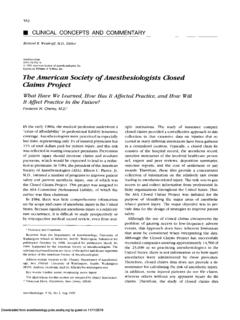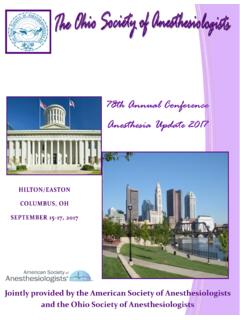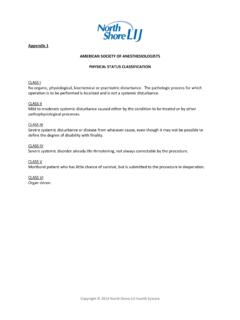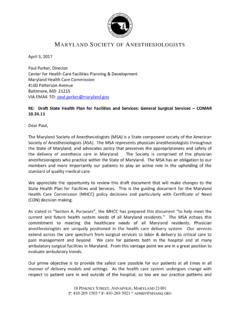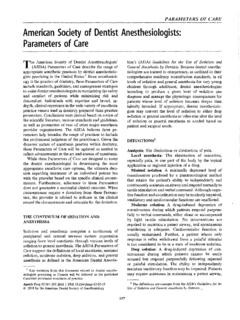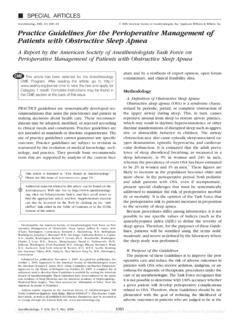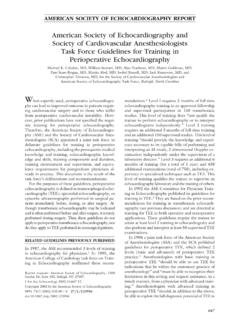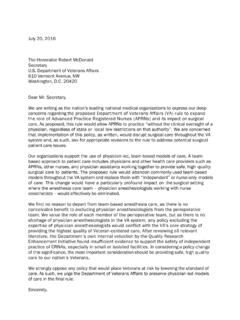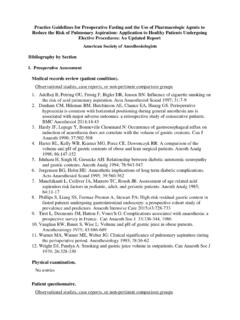Transcription of American Society of Anesthesiologists’ Lifeline to Learning
1 Anesthesiology, V 120 No 1 7 January 2014 EDUCATION has been one of the core missions of the anesthesiology specialty and of the American Society of Anesthesiolo-gists (ASA) since the early days of postgraduate medical education. From the first public demonstra-tion of the use of ether,1 the spe-cialty has been at the forefront of education with innovation such as simulation-based training. Dur-ing this time, continuing medical education (CME) has undergone significant change and continues to evolve in response to the regula-tory environment to ensure that it is evidence based and is not biased. In the past 5 yr, the ASA has made major changes to its education strategy and continues to evolve its programs to meet the education needs of members including many activities to fulfill the require-ments for Maintenance of Certifi-cation (MOC) and to improve the quality of care delivered to PerspectiveThe era of modern CME began in 1968 with the creation of the American Medical Association Physician Recognition Award and the formation, 13 yr later, of the Accreditation Council for Continuing Medical Education.
2 During the early years of formal CME, the focus of CME profession-als was primarily on attendance; but, for the past 10 to 15 yr, there has been increasing emphasis on demonstrating the effectiveness of CME in improving individual patient out-comes and overall population health. Several parallel forces have shaped CME for medical specialties in general and the specialty of anesthesiology in particular. These factors include the introduction of MOC, new criteria for accredi-tation of CME activities, and a renewed focus on quality in healthcare stemming from the Affordable Care 1998, the American Board of Medical Specialties introduced a new paradigm for ensuring that physicians certified by their member boards are keeping current in the knowledge and skills needed to provide the best care to patients. MOC requires phy-sicians to assess their own prac-tice to determine their needs and then seek information/education to close self-identi-fied knowledge, competence, and performance gaps.
3 This is the basic premise of continu-ous Learning and assessment at the individual practitioner level. Following the American Board of Medical Specialties criteria, the American Board of Anes-thesiologists has set out specific requirements for lifelong learn-ing for physician-anesthesiolo-gists including: Part 1: Professional standing Part 2: Lifelong Learning and self-assessment Part 3: Cognitive exam Part 4: Practice performance assessment and improvementIn 2006, and on the heels of the increased concern regarding the role of pharmaceutical and device manufacturers in CME and the effect on physicians practices, the Accreditation Coun-cil for Continuing Medical Education introduced new criteria for accrediting CME activities. In response to the evolution in CME, the ASA created the Education Division in 2009 and, a year later, an ad hoc Committee on Education Planning convened the first Education Summit in 2010 to formulate a strategic plan for educational activities the Blueprint for ASA Education 2011 2014.
4 The Blueprint included the continua-tion of core CME activities, for example, the Anesthesiology Continuing Education and Self-Education and Evaluation Programs, and outlined new CME initiatives to meet the edu-cational needs of a growing passage of the Affordable Care Act and the 2012 Supreme Court decision to uphold it have increased phy-sician-anesthesiologists desire to have more detailed infor-mation about its impact on their practices. ASA s strong education program in practice management has been instru-mental in keeping members up-to-date on the evolution of healthcare Society of Anesthesiologists Lifeline to LearningB. Diane Gambill, 2013, the American Society of Anesthesiologists, Inc. Lippincott Williams & Wilkins. Anesthesiology 2014; 120:7-9 The vision for the future of ASA Education is to pro-vide personalized education on topics derived from data-driven needs assessments.
5 Image: for publication September 5, 2013. From the American Society of Anesthesiologists, Park Ridge, from by guest on 29 November 2021 Anesthesiology 2014; 120:7-9 8 B. Diane GambillEditorial ViewsMeasuring Education EffectivenessAccreditation Council for Continuing Medical Education criteria for accredited CME require that continuing edu-cation improve physician competence, performance, and patient outcomes and that CME providers measure the change to show that the delivered education was effective. Best practices for planning, executing, and evaluating indi-vidual CME activities to satisfy these requirements have been published by Moore et Moore model describes an approach which is cyclical in nature and starts with the desired end result or outcome in mind: improvement in population health. A specific desired outcome is derived from a needs assessment starting with identified suboptimal outcomes in popula-tion health and mapping them to gaps in physician knowl-edge, competence, or performance.
6 The efficacy of CME activities is evaluated through pretest, posttest, and follow-up evaluations designed to measure closure of the gap. The continuous cycle ends and restarts when data are collected from evaluations and used to measure the effectiveness of the activity in terms of meeting the Learning objectives and desired outcomes. The evaluation data can also reveal new or persisting gaps that can be used to design additional education CME activities can be tricky, especially when it comes to evaluating physician skills associated with performance, patient outcomes, and population health. It is clear that the factors contributing to changes in phy-sician performance, patient outcomes, and population health cannot be derived from a single 60-min episode of Learning . Principles of adult Learning in general, and physi-cian Learning in particular, describe a multistep sequence in achieving awareness/knowledge of new information, applying new knowledge in appropriate settings (compe-tence), and incorporating new knowledge/skills into prac-tice (performance).
7 Thus, evaluations should be designed to assess the collective effectiveness of all activities in a program that address a particular desired outcome. This speaks to the importance of defining the desired outcomes in the earliest planning stages of educational activities and identifying the needs-based gaps that are most likely to be the end in mind, the best way to approach edu-cation that can ultimately improve population health is to have accurate data on current healthcare outcomes. Although much of the data can be gleaned from the peer-reviewed literature, it is much better to have patient data from clinical registries. The Anesthesia Quality Institute (AQI) provides us with a start. With more than 10 mil-lion cases in the database, we can begin to analyze patient outcomes and identify areas where outcomes might be improved. Toward that end, a joint ASA AQI study is underway to analyze the impact of targeted education on patient-centered performance measures.
8 One of the measures identified in the AQI database with potential for improvement through physician and patient educa-tion is postoperative nausea and vomiting. There is a high degree of variability among providers in postopera-tive nausea and vomiting rates suggesting that, for those with high rates, there is room for measurable improve-ment through education and implementation of effective preventive techniques. A second source of data on spe-cific outcomes measures comes from self-assessment and performance improvement activities, both of which are included in MOC. Each topic among the suite of perfor-mance improvement activities includes specific measures. By analyzing initial practice pattern for each of the mea-sures, it is possible to identify gaps in patient care that can be addressed by targeted education. Finally, data from simulation-based training can similarly provide us with performance data that can lead to specific educational interventions aimed at improving population DirectionsAs the healthcare environment continues to change, the ASA is evolving its education strategies to stay on the leading edge.
9 To further meet the needs of physician-anesthesiologists relating to these changes, the ASA Education Division will hold the first ASA Quality Meeting: Creating and Measuring Quality in Anesthesiology in November 2013. This meeting was designed to provide anesthesiology-specific education on quality improvement and the time of this writing, plans for the second Educa-tion Summit, to be held in November 2013, are well under-way. The theme of the 2013 Summit is What Education Do Anesthesiologists Need for Future Practice? Identifying, Under-standing, Adapting to and Embracing Change and will address four domains: Changes in delivery of patient care (medical science) Defining, measuring, and improving value (system science) Managing evolving models of team-based care (organi-zation science) Understanding and implementing new technologyThe ASA has a tremendous opportunity to continue the tra-dition of using science and research to advance the specialty.
10 Mining data from the AQI, Anesthesiology, and the overall ASA education program to identify ways to improve patient outcomes with targeted education will further cement the role of physician-anesthesiologists as leaders in patient safety. It is critically important that the specialty engages in peri-operative outcomes research to stay on the cutting edge of education and innovation by leveraging data from the AQI, joint ASA AQI initiatives in performance improvement, and aggregate evaluation data derived from the ASA portfo-lio of CME vision for the future of ASA Education is to pro-vide personalized education on topics derived from data-driven needs assessments. This strategy can be used to create Downloaded from by guest on 29 November 2021 Anesthesiology 2014; 120:7-9 9 B. Diane GambillEDITORIAL VIEWS longitudinal Learning plans designed to guide physician-anesthesiologists through the complexities of MOC and other education initiatives critical for improving patient care and outcomes.
